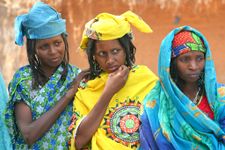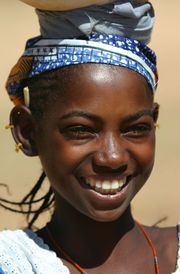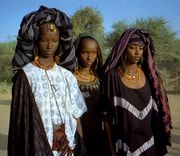Fula people
 Fula women. |
| Regions with significant populations |
|---|
| Guinea, Nigeria, Cameroon, Senegal, Mali, Sierra Leone Central African Republic, Burkina Faso, Benin, Niger, Gambia, Guinea Bissau, Ghana, Chad, Mauritania, Sudan, Togo, Côte d'Ivoire. |
| Languages |
| Religion |
| Related ethnic groups |
|
Wolof and Serer |
| person | Pullo |
| people | Fulɓe |
| language | Pulaar (west), Fulfulde (east) |
Fula or Fulani or Fulbe (the latter being an Anglicisation of the word in their language, Fulɓe[1]) are an ethnic group of people spread over many countries, predominantly in West Africa, but found also in Central Africa and Sudanese North Africa. The countries in Africa where they are present include Mauritania, Senegal, Guinea, The Gambia, Mali, Nigeria, Sierra Leone, Benin, Burkina Faso, Guinea Bissau, Cameroon, Côte d'Ivoire, Niger, Chad, Togo, the Central African Republic, Ghana, Liberia, and as far as Sudan in the east. Fula people form a minority in every country they inhabit, but in Guinea they represent a plurality of the population (40%).Total population 27 000 000.[2]
Contents |
Terminology

There are also many names (and spellings of the names) used in other languages to refer to the Fulɓe. Fulani in English is borrowed from the Hausa term, and it is also used by the Manding peoples, being the diminutive form of the word "Fula" in their language, essentially meaning "little Fula". Fula, from Manding languages is also used in English, and sometimes spelled Fulah or Foulah. Fula and Fulani are commonly used in English, including within Africa. The French borrowed the Wolof term Pël, which is variously spelled: Peul, Peulh, and even Peuhl. More recently the Fulfulde / Pulaar term Fulɓe, which is a plural noun (singular, Pullo) has been adapted to English as Fulbe, which some people use. In Portuguese it's Fula or Futafula.
Related groups
A closely related group is the Tukolor (Toucouleur) in the central Senegal River valley. These people are often referred to together with Fulɓe of the region as Haalpulaar'en (Pulaar-speakers). Fula society in some parts of West Africa features the "caste" divisions typical of the region. In Mali, for instance, those who are not ethnically Fula have been referred to as yimɓe pulaaku (people of the Fula culture).
The Woɗaaɓe, also known as the Bororo, are a subgroup of the Fula people.
Traditional livelihood
The Fulani are traditionally a nomadic, pastoralist, trading people, herding cattle, goats and sheep across the vast dry hinterlands of their domain, keeping somewhat separate from the local agricultural populations.

History

Origins and spread
While some have speculated over the origin of Fulani people, current linguistic and genetic evidence suggests an indigenous West African origin among the Peul.[3] The vast majority of genetic lineages associated with them reflect those most commonly seen in other west Africans. Their language is also of west African origin, most closely related to that of the Wolof and Serer ethnic groups.[1]. Historical and archaeological records indicate that Peul-speakers have resided in western Africa since at least the 5th century A.D. as well. Interestingly, rock paintings in the Tassili n'Ajjer suggests the presence of proto-Fulani cultural traits in the region by at least the fourth millennium B.C. Scholars specializing in Fulani culture believe that some of the imagery depicts rituals that are still practiced by contemporary Fulani people.[4]
Rise to political dominance
Beginning as early as the 17th and 18th centuries, but mainly in the 19th century, Fulas and others took control of various states in West Africa.
These included the Fulani Empire, also known as the Sokoto Caliphate, founded by Usman dan Fodio (which itself included smaller states), Fouta Djallon, Massina and others.
Culture & Language
The language of Fulas is called Pulaar or Fulfulde depending on the region, or variants thereof. It is also the language of the Tukulor. All Senegalese who speak the language natively are known as the Halpulaar or Haalpulaar'en, which stands for "speakers of Pulaar" ("hal" is the root of the Pulaar verb haalugol, meaning "to speak"). In some areas, e.g. in northern Cameroon, Fulfulde is a local lingua franca.
With the exception of Guinea (where the Fula make up a ~40% plurality of the population), Fulas are minorities in every country they live in (most countries of West And East Africa). So some also speak other languages, for example:
- Portuguese and Kriol in Guinea-Bissau
- Arabic in Sudan particularly in Tulus in Darfur, Ghadarif and Blue Nile
- French and Arabic in Mauritania
- Hausa and French in Niger
- French and English in Cameroon
- Wolof and French in Senegal
- Sango and French in Central African Republic
- Bambara and French in Mali
- English in The Gambia
- Liberian English in Liberia
- English, Hausa and Ghanaian languages in Ghana
- English and some indigenous languages in Sierra Leone, particularly Krio, the lingua franca.
- Other Nigerian languagess and English in Nigeria

Clothing

The traditional dress of the Fula consists of long colorful flowing robes, modestly embroidered or otherwise decorated. Also characteristic Fula tradition is that of women using Henna around the mouth, resulting in a blackening around the lips. Fula ethics are strictly governed by the notion of pulaaku. Men wear long robes to the lower calves with trousers of cotton.Herdsmen wear the distinctive conical straw hat and a turban. Women wear long robes and turbans.They decorate themselves with necklaces, earrings, nose rings and anklets.[5]
Herding
Fula are primarily known to be pastoralists, but are also traders in some areas. Most Fula in the countryside spend long times alone on foot, moving their herds; they were the only major migrating people of West Africa, though most Fula now live in towns or villages. Wealth is counted by how large the herd of cattle is and how many cattle.Long ago fulani tribes used to fight over cattle.
Music
The Fula have a rich musical culture and play a variety of traditional instruments including drums, hoddu (a plucked skin-covered lute similar to a banjo) and riti or riiti (a one-string bowed instrument similar to a violin), in addition to vocal music. The well known Senegalese Fula popular musician Baaba Maal sings in Pulaar on his recordings. "Zaghareet" or ululation is a popular form of vocal music formed by rapidly moving the tongue sideways and making a sharp, high sound.
Food
Traditional food The Fulani eat millet, milk and meat as staples. Millet is eaten in the morning, noon and night as a porridge with a sauce or stew which usually contains, tomatoes, peppers, bone, meat, onion and water. Meat such as goat is usually eaten at special occasions as well as beef. A thick beverage similar to the tuareg beverage eghajira, is made by pounding goat cheese, milk, dates and millet.
Houses
Fula live in domed houses during the dry season. The domed house is supported by compact millet stalk pillars. During the wet season the house is covered by reed mats.
Notable Fulani people by country
Nigeria
- Usman dan Fodio, founder, Sokoto Caliphate
- Nana Asma’u, scholar and author, Sokoto Caliphate
- Umaru Yar'Adua, former President of Nigeria
- Shehu Shagari, Former Nigeria President
- Muhammadu Buhari, former Nigerian Head of State
- Ahmadu Bello, first Premier of Northern Nigeria
- Atiku Abubakar, former Vice President of Nigeria
- Shehu Musa Yar'Adua, Nigerian politician and the brother of former Nigerian president Umaru Yar'Adua
- Sir Abubakar Tafawa Balewa, Nigerian father and first prime minister
- Vice-Admiral Murtala Nyako, current Governor of Adamawa State,former Chief of Naval Staff
- Justice Salihu Moddibo Alfa Belgore, former Chief Justice of the Federation
- Ibrahim Gambari, Under Secretary-General/Special Adviser - Africa in the UN; former Minister of Foreign Affairs.
- Professor Jibril Aminu, pioneer cardiac surgeon, former minister of education and petroleum.
Senegal
- Malick Daouda Sy (to not confuse with El Hadj Sayyid Malick Sy), Imam and founder of the Fulbe Islamic Kingdom of Bundu(French: Boundou) in 1690 in the est of Fuuta-Tooro
- Bubu Malick Sy,son of Malick Daouda Sy,king of Bundu
- Souleymane Baal, founder of Fuuta-Tooro Islamic state (circa 1750)
- Cheikh Abdul Karim Kane, successor to Souleymane Baal
- Cheikh Umar Tall, General Khalif (1850–1865) of the Tijaniyya suufi way (tarikh) for West Africa
- Maba Diakhou Ba Almamy of Rip
- Malick Sy marabout
- Sheikh Hamidou Kane, writer, author of the autobiographical novel L’Aventure ambiguë (1961; Ambiguous Adventure), that considers the African and Muslim identity
- Habib Thiam, former Prime minister of president Abdou Diouf
- Daouda Sow, former head of the parliament
- Amadou Cledor Sall, former interior minister
- Baaba Maal, composer, singer, head of the band Daande Leñol
- Mariam Bâ, writer Une si longue lettre
- Oumou Sy, fashion designer
- Ibrahim Ba, French-Senegalese former football player
- Moussa Ba, professional kickboxer
- Mamadou Niang, football player
- Issa Ba, football player
- Tidiane Anne, radio personality
- Yero Doro Diallo, radio personality
Guinea
- Alfa Ibrahima Sambegu (Karamoko Alfa mo Timbo] First ruler of the islamic state of Fuuta-Jalon, head of the Alfaya branch of the Seediyaaɓe dynasty of Timbo
- Alfa Mamadou Sellu Diallo, Karamoko Alfa mo Labe, first lord of the Diiwal (province) of Labe, circa 1726.
- Mama Tofi, Zoubairou Diallo, Former chief of Binani (Solou Bombi, Kalia, etc..) Head of the branch of Tofiyabe or Tofiyanke in Binani, Gaoual, GUINEA. Ancestor of Thierno Sarafudine Diallo Chief of Kalia, Bougoume, Bombi, etc...
- Ibrahima Sori Yero Poore aka Ibrahima Sori Mawɗo (1730–1764). Second ruler of Fuuta-Jalon after Karamoko Alfa and the first to hold the Almaami title, head of the Soriya branch of the Seediyaaɓe dynasty of Timbo.
- Tierno Muhammadu Samba Mombeya, (1765–1850), author of Oogirde Malal, co-founder, with Usman ɓii Foduyee, of Pular [ajami] literature
- Boubacar Biro Barry Buubakar dit Bocar Biro The Last Almaami of Fuuta-Jalon, died at the battle of Poredaka in 1896
- Alfa Yaya Diallo (1850–1912), former Chef of Labé, arrested by french colonialist. The national anthem of the republic of Guinea was adapted by musicians Jean Cellier and Fodeba Keita, from the Alfa Yaya praise-song, composed by a Griot circa 1900.
- Tierno Aliyyu Ɓuuɓa Ndiyan (1855–1927). Author, theologian, Tijaniyya suufi.
- Thierno Diawo Pellel, (1900-1984), islamic theologist, scholar and poet, student of Thierno Aliyyu Ɓuuɓa Ndiyan
- Saifoulaye Diallo (1923–1981), former Guinean politician, first president of the national assembly (1958–1963) held various cabinet positions under the regime of Sekou Toure
- Diawadou Barry [2] (1917–1969), accountant, descendant of the Soriya branch of the former ruling family of Fuuta-Jalon, leader of Bloc Africain de Guinea political party, opted for the No vote in the 1958 French referendum. Executed secretely at [Camp Boiro] in May 1969.
- Barry Ibrahima aka Barry III, lawyer, politician, head of Democratie Socialiste de Guinée, arrested, tried and sentenced in absentia, hanged publicly on Jan. 25, 1971 in Conakry under the dictatorship of president [Sékou Touré].
- Ousmane Poreko Diallo [3]. Ethnographer and author ; his fieldwork documents various aspects of Fulɓe traditional and changing culture ; he worked successively at Centre IFAN-Guinée (under French rule) and at Institut National de la Recherche et de la Documentation (INRD) of the republic of Guinea.
- Diallo Telli (or Boubacar Telli Diallo [4]), Lawyer, former Diplomat, First Sec. Gen. of the Organization of African Unity, died of starvation at [Camp Boiro][5] in 1977.
- Cellou Dalein Diallo, Prime Minister of Guinea from 2004–2007
- Bobo Balde, football star
- Katoucha, former haute couture model and anti-female circumcision activist
- Abdoul Salam Sow, former footballer
- Abdallah Bah, football star
- Ibrahima Diallo, football star
- Alpha Yaya Diallo, musician
- Almamy Schuman Bah, football star
- Amadou Diallo, young resident in the Bronx killed by police in 1999
- Habib Diallo, former Diplomat and Minister, actually Mano River Union Secretary-General
- Saidou Diallo, former Diplomat and Minister,
- Amadou Poredaka Diallo, former Minister
- Boubacar Biro Diallo, former politician and head of the parliament
- General Bailo Diallo, former minister of Defense
Mali
- Amadou Hampâté Bâ, researcher and author
- Seku Ahmadu, Founding King of Fula Kingdom of Macina, Mopti
- Alpha Balobo Bocary, nephew of Seku Ahmadu and general of his Army
- Adame Ba Konaré, historian and spouse of the former president Alpha Oumar Konaré
- Amadou Toumani Touré, Malian President
- Hamadoun Dicko, intellectual and political figure of PSP party along with Fily Dabo Sissoko
- Prof. Bocar Sall, medical doctor, Political figure and former V.P. of National Assembly
- Ali Nouhoum Diallo, Medical Doctor, political figure and former president of National Assembly
- Mountaga Tall, lawyer and political figure founding president of CNID party and ex-V.P. of National Assembly
- Ibrahima Bara Sambarou Sarre, traditional Malian Fula hoddu player, Kontza, Mopti
- Yero Assikula Bah Kouyate, Fula traditional guitarist and story teller, Mopti
- Samba Sidibe, journalist ORTM Bamako
- Sidi Modibo Kane Diallo, Muslim erudit of Dily, Kayes
- Hambodejo Hampathe, King of Kounary, Mopti
- Gueladjo Hambodejo, successor of Hambodejo
- Ahmadou Lam Djoulde Tall, Emperor of Segou
- Boubacar Sada Sy, former Malian Defense Secretary (Ministre de la defense)
- Ousmane Sy, politician
- Sy Kadiatou Sow, Malian politician and spouse of Ousmane Sy
- Ma Demba Sy, King of Sissany in Mali, under the French colonists
Sierra Leone
- Amadu Wurie, early Sierra Leonean educationist and politician
- Amadu Jalloh, Sierra Leonean politician
- Alimamy Rassin, Sierra Leonean chief during colonial period
- Minkailu Bah, Sierra Leone's minister of Education, Youth and Sports
- Sulaiman Tejan-Jalloh, Sierra Leone ambassador to the United Kingdom
- Abubakarr Jalloh, Sierra Leone Minister of Mineral Resources
- Alimamy Jalloh, Sierra Leonean football star
- Mahmadu Alphajor Bah, Sierra Leonean football star
- Rashid Wurie, former Sierra Leonean international football star
- Saajo Bah, Editor of www.peeral.com , one of the few online magazines published in African languages.
- Umu Hawa Tijan Jalloh, Sierra Leone´s 1st Chief Justice
- Dr Abdulai Timbo, former Sierra Leone´s Chief Justice
- Abdulai Jalloh, former national footballer
- Mohamed Jalloh, former national footballer
- Ibrahim Bah, former national footballer
Burkina Faso
- Thomas Sankara, Former President of Burkina Faso
- Youssouf Sambo Bâ, Burkinabe politician
- Bénéwendé Stanislas Sankara, Burkinabe politician
Cameroon
- Ahmadou Ahidjo, first President of Cameroon
- Issa Hayatou, current President African Football Confederation (CAF)
- Bello Bouba Maigari, political leader
- Garga Haman Adji, former minister and political leader
Mauritania
- Mamadou Samba Diop Murtudo, writer, historian, Fulani educator
The Gambia
- Hamat Bah, Politician, opposition Leader
- Halifa Sallah, politician, writer
See also
- Wodaabe
- Hausa people
- Mandé people
- Songhai people
References
- ↑ The letter "ɓ" is an implosive b sound. In the orthography for languages of Guinea (pre-1985), it was written bh, so one would have written Fulbhe instead of Fulɓe. Some people still use this spelling convention.
- ↑ People Guinea: People. CIA World Factbook. 14 May 2009 update. Accessed 2009-06-05.
- ↑ mtDNA of Fulani Nomads and Their Genetic Relationships to Neighboring Sedentary Populations
- ↑ The Fulani/Fulbe People | Thematic Essay | Timeline of Art History | The Metropolitan Museum of Art
- ↑ Pulaaku Ethics
- Almanach de Bruxelles (now a paying site)
- Gordon, Raymond G., Jr. (ed.) (2005): "Adamawa Fulfulde". Ethnologue: Languages of the World, 15th ed. Dallas: SIL International. Accessed 25 June 2006.
- Ndukwe, Pat I., Ph.D. (1996). Fulani. New York: The Rosen Publishing Group, Inc.
- Christiane Seydou, (ed.) (1976). Bibliographie générale du monde peul. Niamey, Institut de Recherche en Sciences Humaines du Niger
Further reading
- Prof. Mark D. DeLancey's Fulbe studies bibliography, Accessed 25 March 2008.
External links
- webPulaaku Portal of Fulɓe history and culture
- Online magazine published/edited in Fulfulde by Saajo Bah
- Online magazine published/edited in Fulfulde by Ibrahima Sarr
- Online magazine in Fulfulde published by Fedde Bamtaare Pulaar in Mauritania
- Online Magazine published/edited by Ibrahima Ly
- Fulfulde online paper
- Fulfulde online news site published/edited by Lewlewal Group
- Fulfulde online news site published/edited by Lewlewal Group
- KJPF Egypt
- Online bilingual dictionary authored by Oumar Bah
- Mini trilingual dictionary of political and legal terminology
- Mini bilingual dictionary of mathematical terminology
- Portal of Fulɓe Fuuta Jaloo history and culture
- based in USA/ published by Pulaar Speaking Association
- WorldStatesmen - Nigerian Traditional states
|
|||||